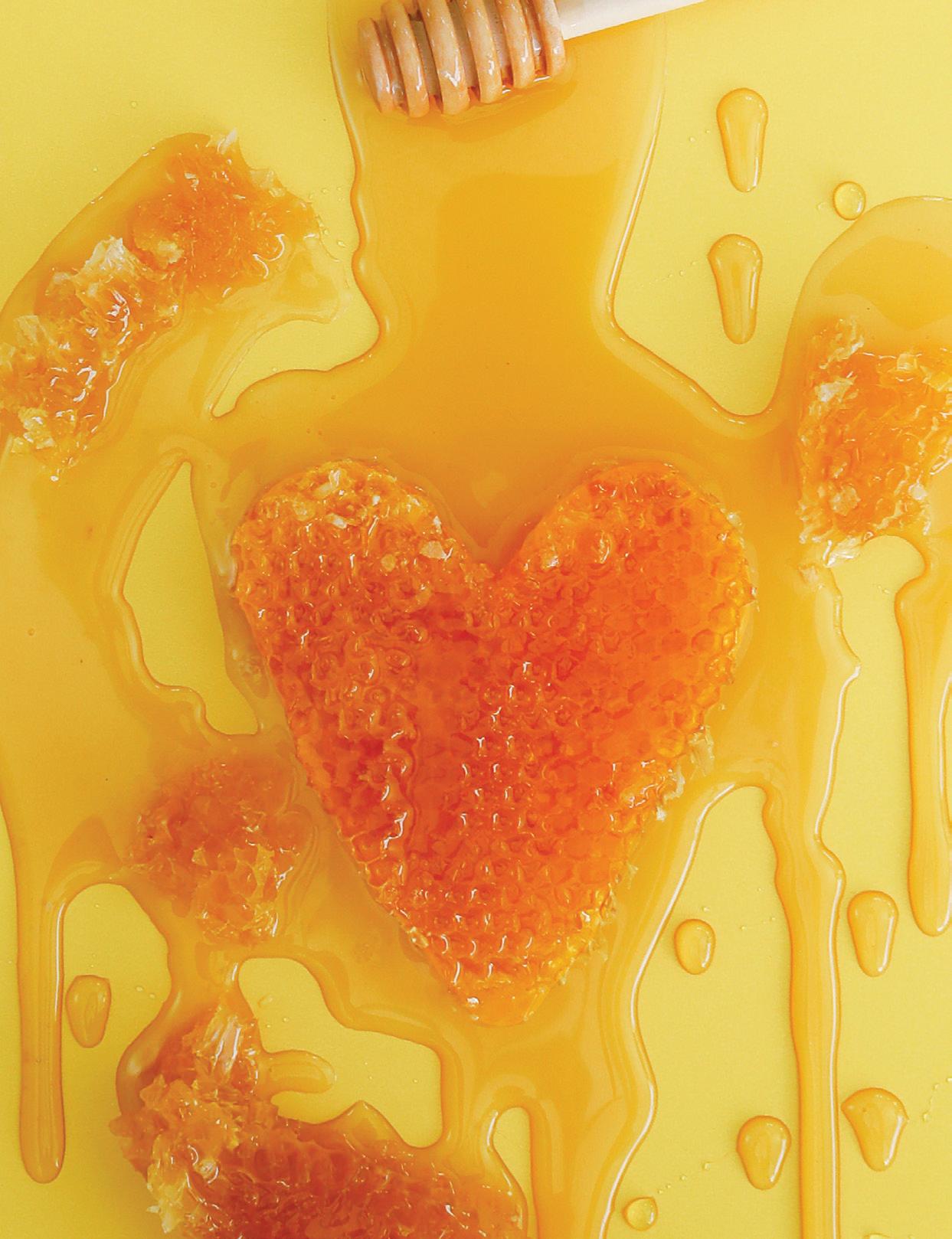
BRINGING ALABAMA TO LIFE
BRINGING ALABAMA TO LIFE


BRINGING ALABAMA TO LIFE
BRINGING ALABAMA TO LIFE





I am continually inspired by the creativity, dedication and excellence of our small but passionate team at JOY magazine. Jennifer Kornegay, Erika Tracy and Nancy Fields consistently craft a publication that resonates deeply with our readers, and this summer issue is no exception. The articles are compelling, and the photography and design are truly outstanding. Working alongside these talented women is both an honor and a joy.
One of the heartfelt stories in this issue features Sarah Murphy, who shares her remarkable journey through breast cancer. At just 38 years old, Sarah never imagined that her first mammogram would lead to a diagnosis. Thanks to early detection, she underwent a mastectomy and reconstructive surgery and is now doing well. Her story is a powerful reminder of the importance of support, resilience and choosing hope—turning fear into a story of triumph.
We’re also excited to introduce the first profile in our new “Healthcare Heroes” series, featuring Dr. Scott McDaniel. His inspiring story includes his own battle with cancer and how those experiences have shaped his compassionate approach to patient care.

Additionally, we welcome Deanne Allegro, owner of the Perennial Restaurant in Montgomery, as a healthy food contributor. Deanne shares delightful recipes made with fresh, local honey—from savory dishes to the classic Bees Knees Cocktail—that are perfect for summer gatherings. You’re sure to love these tasty treats!
Finally, we have exciting news from the Joy to Life Foundation. We’re reimagining our popular “Walk of Life” event for 2025, and it’s now called the “Walk of Life Remix.” Read all about it in this issue. We can’t wait to share this new chapter with you.
Thank you for your continued support and as always, here’s to health, happiness and joy to life!
PUBLISHER
JTL Publishing
EDITOR
Joy Blondheim
MANAGING EDITOR
Jennifer Stewart Kornegay
ART DIRECTOR
Erika Rowe Tracy
DIGITAL MEDIA PRODUCERS
Big Dreamz Creative
CONTRIBUTING WRITERS
Deanne Allegro, MS, RDN Kym Klass
Jennifer Stewart Kornegay
COPY EDITOR
Jenny Sue Stubbs
CONTRIBUTING PHOTOGRAPHERS
Big Dreamz Creative
April Bagley Photography
COVER CREATIVE & PHOTOGRAPHY
Nancy Fields/Big Dreamz Creative
COVER DESIGN
Erika Rowe Tracy
Joy Blondheim Editor & Co-Founder,
Joy to Life Foundation
Joy is published four times per year by JTL Publishing. © 2025 All rights reserved. Reproduction in whole or part is prohibited without permission from the publisher. Joy reserves the right to determine the suitability of all materials submitted for publication and to edit all submitted materials for clarity and space. Joy is not responsible for damage, loss or any other injury to unsolicited manuscripts and/or unsolicited artwork. This includes, but is not limited to, drawings, photography, transparencies or any other unsolicited material. Joy does not knowingly accept false or misleading advertising or editorial. The publishers do not assume responsibility should such advertising or editorial appear. Joy is a news magazine with information on health, leisure activities and a healthy lifestyle. Readers are advised to consult their physicians before participating in any sport or fitness activity or starting any exercise, dietary or nutritional program published in Joy

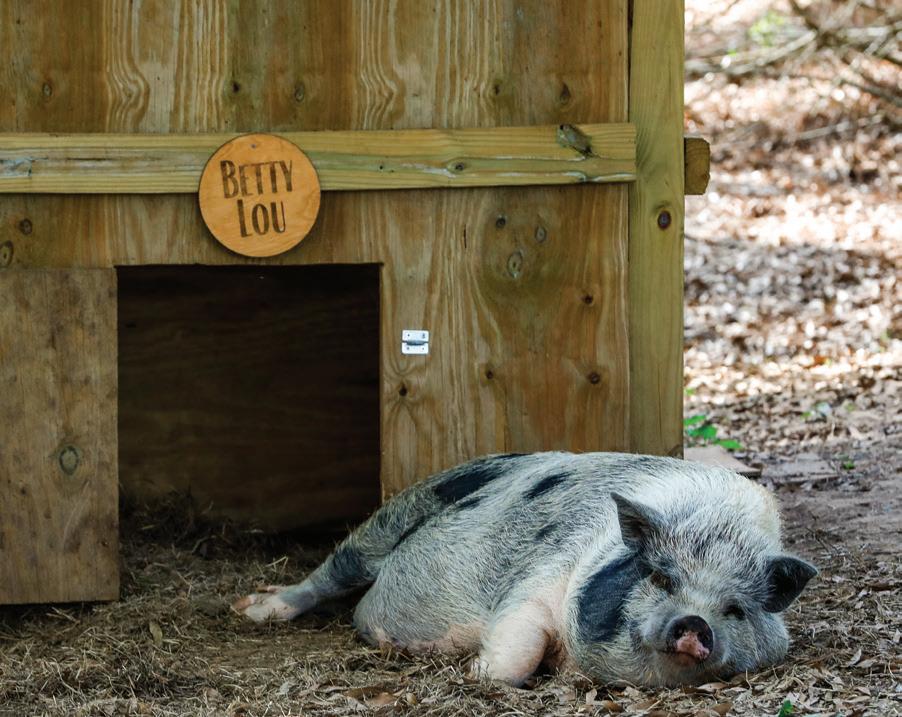
Animals and people who care about them find peace, quiet and a path to a positive life at Real Happy Farm.
Real Happy Farm is delivering on its name by providing a safe home for abandoned and mistreated animals. The pigs, donkeys, goats, cows and chickens who roam its fields are nurtured and loved, forging a new life beyond whatever bad situation they were rescued from. Oh, and the people caring for them—Milla Chappell, her husband and two daughters —are often all smiles, too. Together, the entire Real Happy Farm family is thriving on 43 acres in rural Headland, Alabama.

BY JENNIFER S. KORNEGAY


It all started 1,000 miles away in bustling Manhattan where Milla ran a business photographing pet dogs for clients who wanted professional images of their beloved pooches; her business’ Instagram account was Real Happy Dogs. In her free time, she turned her photography talent into a tool to help dogs in need, donating her skills to area rescue groups and snapping cute pictures of dogs they hoped to place in a new home to gain the pups more exposure. She added those images to her Instagram, too. “I really enjoyed that work, and so I did more and more of it,” she said. Soon, she was working for a New York City group that paired rescue dogs with foster pet parents, and the more doggie pics she posted, the more her following grew. And then it evolved. “It became all about finding these dogs good homes,” she said.
Then in 2021, it changed again. A desire to move closer to family brought the Chappells to Alabama, and Milla’s determination to have space for all kinds of animals led them to buy their farm in Headland in 2022, thus prompting her to change her Instagram account to Real Happy Farm. “Once we had the land, it just made sense to continue my work but now expand it to include other kinds of animals as well,” Milla said.
She’s still photographing dogs, inviting local rescue groups to bring their dogs to the farm for a few weeks, where she captures their sweet faces and posts them for her large nationwide social media audience to gush over. “We ask the rescue groups for the dogs they’ve had the longest so we can help where help is needed most,” Milla said.
She also still works with the foster group in New York and has maintained her original following, meaning she reaches a huge population outside of the South. So often, Alabama rescue dogs end up heading north. To date, Real Happy Farm has relocated more than 20 dogs.
But the farm’s real stars are the barnyard critters who survived difficult backgrounds and got lucky enough to land at Real Happy Farm, where they have a permanent home alongside the Chappell’s four family dogs. “We have this beautiful, mismatched group of animals, and people love them. We love them,” Milla said. And the animals appear to give the love right back, often hamming it up for her camera. Cows give quizzical
looks. Goats stand lookout atop pigs or serve as footstools for reclining kids. Donkeys nuzzle. Currently, four dogs, four horses, two mini horses, two donkeys, two pigs, seven goats and a bunch of chickens and turkeys reside at the farm. Add the rotating roster of dogs up for adoption, and you’ve got quite the menagerie and a few interesting inter-species relationships, like Betty and Bandit. “Betty is one of our pig rescues, and she’s taken up with a baby goat who was abandoned by his mom,” Milla said. “He actually tried to nurse her in the beginning, and now they are together all the time; he sleeps with her at night.”
Milla believes the positive response the animals elicit is in part due to their personalities on display, but also thanks to an overall need for uplifting content. “With how divided the world is now, I think our Instagram provides a safe space where people can come view something that is happy and encouraging,” she says. “It’s a place where we can agree on things because pretty much everyone loves funny, cute animals. I get a lot of feedback that just sharing animal and family content is meaningful to people.”
Real Happy Farm’s feed also shows off a life lived at a more leisurely pace and one more connected to nature, ideas that appeal to many. “That just resonates with a lot of people, especially some of my audience up in the Northeast where the farm life is so different from what they are living but attractive, too,” Milla says.
She knows first-hand how beneficial and satisfying their simpler lifestyle can be, particularly for her two daughters, Rinnah and Ellory. (And a third girl is on the way.) “I have seen them grow so much since we’ve been here,” Milla says. “Rinnah is braver and more willing to try new things. She’s also taking on more responsibility, hopping in to do more chores.”
And while Milla and her family relish being a bit away from it all, they’re not alone; the Chappells enjoy sharing the farm. “We have friends out here a lot so they can experience the peace of the country and get a taste of the way we live,” she said. Real Happy is a hobby farm, but the Chappells do garden and grow a good bit of their own food. “I love that aspect too and being able to share that,” Milla said.

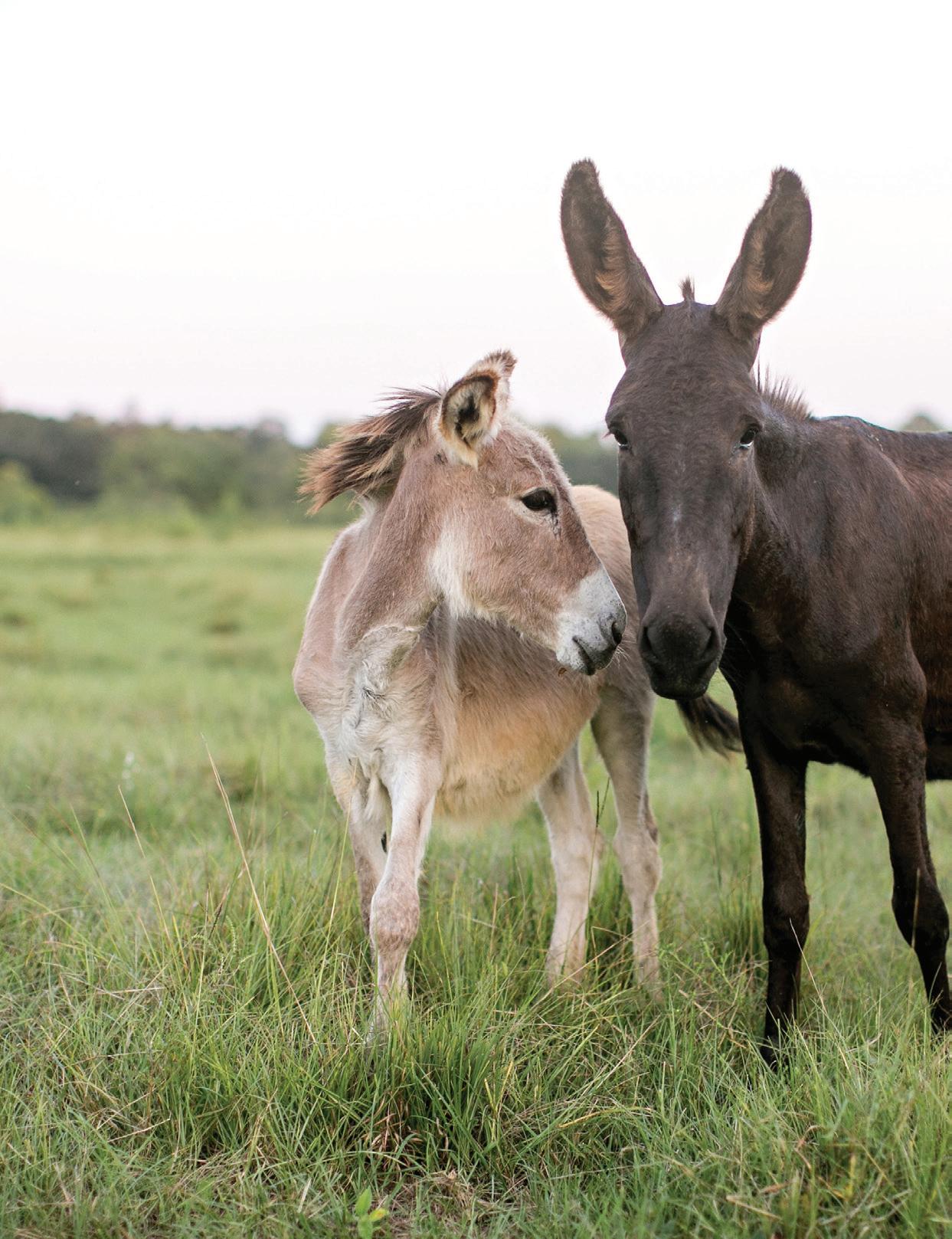
In an effort to do more for animals, Milla established a nonprofit last year. And part of its purpose is providing a vehicle for her to offer more opportunities for the general public to visit the farm, with camps to teach kids about caring for and respecting animals, gardening workshops, farm tours and more.
But she hopes she can pass its magic on even to those who’ll never set foot on Real Happy Farm by encouraging others to give the lifestyle a serious look. “It has been such a huge positive, so if you’ve thought about it, I say, yes, really consider it,” she says. “It can be overwhelming, but if we did it—and we did not grow up this way or live on a farm previously— you can do it. Start small. Take one step at a time toward simplicity; that’s the key.”
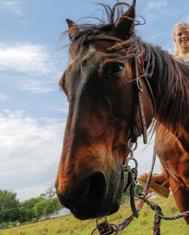
BREED: Quarter Horse
FAVORITE FOOD: Apples
HIS DEAL:
A retired reining horse, he is now living his best life with an 8-year-old girl as his best friend.
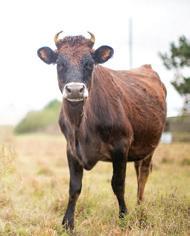
BREED: Jersey Cow
FAVORITE FOOD: Animal Crackers
HER DEAL:
After being sold for meat as a 2-week old calf, she was bottle-raised on the farm with Johnny.
Seven goats rotate through the animal paddocks to keep the land clear. They have funny personalities and always keep us laughing! Bandit is the newest addition known for spending time hopping on the back of Betty Lou the pig.

FAVORITE FOOD: Weeds
BEST FARM FRIEND: Mama
HER DEAL:
By far, the sweetest animal on the farm, Honey lives for grooming and love from her people.

Boss and his ladies freely roam the farm and help keep predators away from the rest of the flock with their gobbles! They are interesting birds with a lot of personality.
BREED: Rhode Island Red Bantam
FAVORITE FOOD: Mealworms
HIS DEAL:
Buck is an unusual rooster who is strongly bonded to Poppy the hen and currently raising a brood of chicks!
There's a lot of love going into the farm, both in real life and online. A hefty social media following helps fuel the farm's mission too.
Check out these opportunities to join in on the farm fun.
@REALHAPPYFARM ON INSTAGRAM: Uplifting, educational and down-right adorable updates keep more than 30,000 followers coming back to Milla's Instagram account for posts and stories on the animals' daily activities. In fact, her platform for animals continues to help foster dogs in Alabama find forever homes throughout the country.
+The Real Happy Farm Kid's Club gives young fans access to the farm too. Members learn about animals in a fun, interactive environment through online book clubs, “ask the vet” events and live streams from the farm.

GEAR UP WITH YOUR FAVORITE FRIEND:
Beautiful drawings of many of Real Happy Farm's fan favorites are available on bookmarks, notepads, stickers and more.
SHOW YOUR SUPPORT:
The Real Happy Farm can be supported through their non-profit organization. A special fund, Pattycake's Fund, in honor of a past farm friend offers financial support to others handling end-of-life expenses for beloved canines.
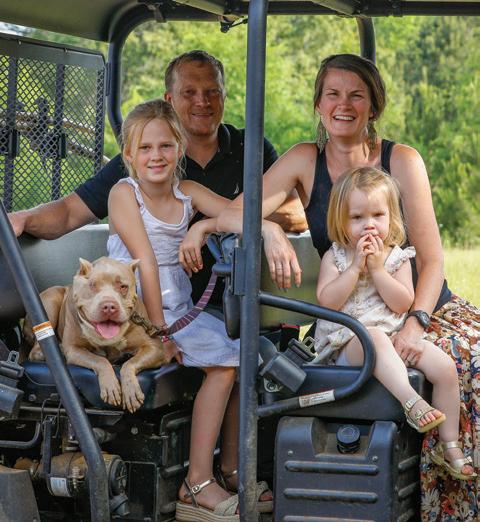

FAVORITE FOOD: Watermelon
BEST FARM FRIEND: Brad
HER DEAL:
Emmy Sue is a loner who decided that farm dad Brad is her bestie.

The entire Real Happy Farm family— Milla Chappell, her husband and two daughters—is thriving on 43 acres in rural Headland, Alabama, since moving from New York in 2021.

FAVORITE FOOD: Apples
BEST FARM FRIEND: Bandit the goat
HER DEAL:
Found at a dog shelter, Betty is a farm favorite!
FAVORITE FOOD: He'll go giddy over licking out the last bits from an empty peanut butter jar.
BEST FARM FRIEND:
Luna and all the foster dogs
HIS DEAL: Wilbur narrowly survived a snake attack to the face and lost his right eye to swelling from the injury.
Two working farm dogs , August and Lady, spend their days (and many nights) patrolling the paddocks and farm borders to keep predators away from the other animals. Plus, the farm has a constant rotation of adoptable dogs visit the farm to help find their homes.
This spring, more than 20 chicks were added to the farm family by the resident hens and roosters.
Add a little liquid gold to sweeten your summertime with these honey-centric recipes.
YeBY DEANNE ALLEGRO, MS, RDN PHOTOGRAPHY BY
CREATIVE
Honey is a preferred sweetener in many recipes due to its ability to keep foods moist, aid in texture and add a more complex flavor than table sugar. At Perennial, we use ingredients we are able to find locally, and a key one we source is honey. You will find it throughout our menus, from beverages and plates to desserts! It’s an ingredient to be celebrated and appreciated, and we’re excited to share a few of these with you.
It is an essential component in the classic Bees Knees cocktail, but we add a unique twist by infusing the honey with local edible flowers (like wisteria and rose) for an even more delightful drink.
In our kale salad, a zingy honeymustard dressing pairs perfectly with the vitamin-packed green. I particularly love the way the tangy sweetness of the dressing clings to the leaves.
And when baking the Satsuma Honey Chicken, the honey sauce forms a sweet crispy layer that gets an additional flavor boost from cumin’s warm earthiness.

Deanne Allegro, MS, RDN is an Associate Clinical Professor of Nutrition at Auburn University at Montgomery and the owner of Montgomery’s freshfocused restaurant, Perennial. She has more than 20 years of experience in the fields of food and nutrition.
INGREDIENTS:
2/3 cup of cooked quinoa
1 bunch of curly kale, thick part of stems removed, leaves cut into small slices*
1 apple, cored 1/2 cup pecans
1/2 cup farm aged cheddar cheese
1 tablespoon olive oil
DIRECTIONS
Make the dressing. Preheat the oven to 400 degrees. Toss the fully cooked quinoa with olive oil and spread evenly on a baking sheet. It should be a thin layer. Bake for 15-20 minutes, until the quinoa is dry and crunchy.
Chop the kale and place into a large bowl. Pour the dressing over the kale and using your hands, massage the dressing into the kale.*
Dice the apple and add to the kale, along with the pecans.
Add the quinoa and toss. Top with thinly shredded cheddar cheese.
*Kale can be a tougher green. To soften it, cut the leaves into small, thin slices and massage before putting the full salad together.
INGREDIENTS:
2 tablespoons country Dijon mustard
2 tablespoons extra virgin olive oil
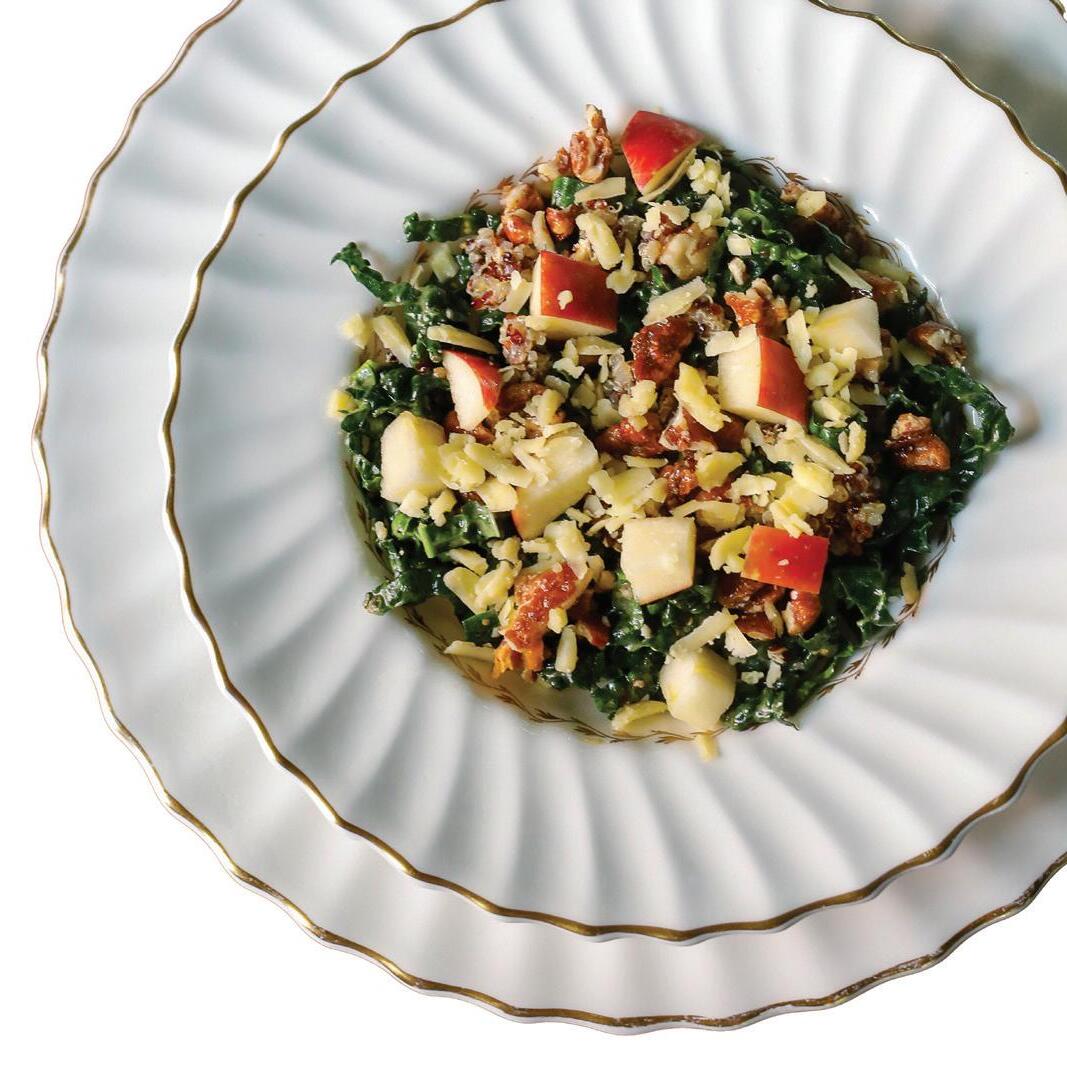
2 tablespoons apple cider vinegar
1 tablespoon honey
1 small garlic clove, grated or minced
Pinch of chile flakes
Salt and pepper to taste
DIRECTIONS
In a small bowl, whisk together ingredients.
Substitute the gin for chilled lemon balm tea and top with the sparkling beverage of choice We use a house made ginger ale kefir, but any sparkling water would also work.

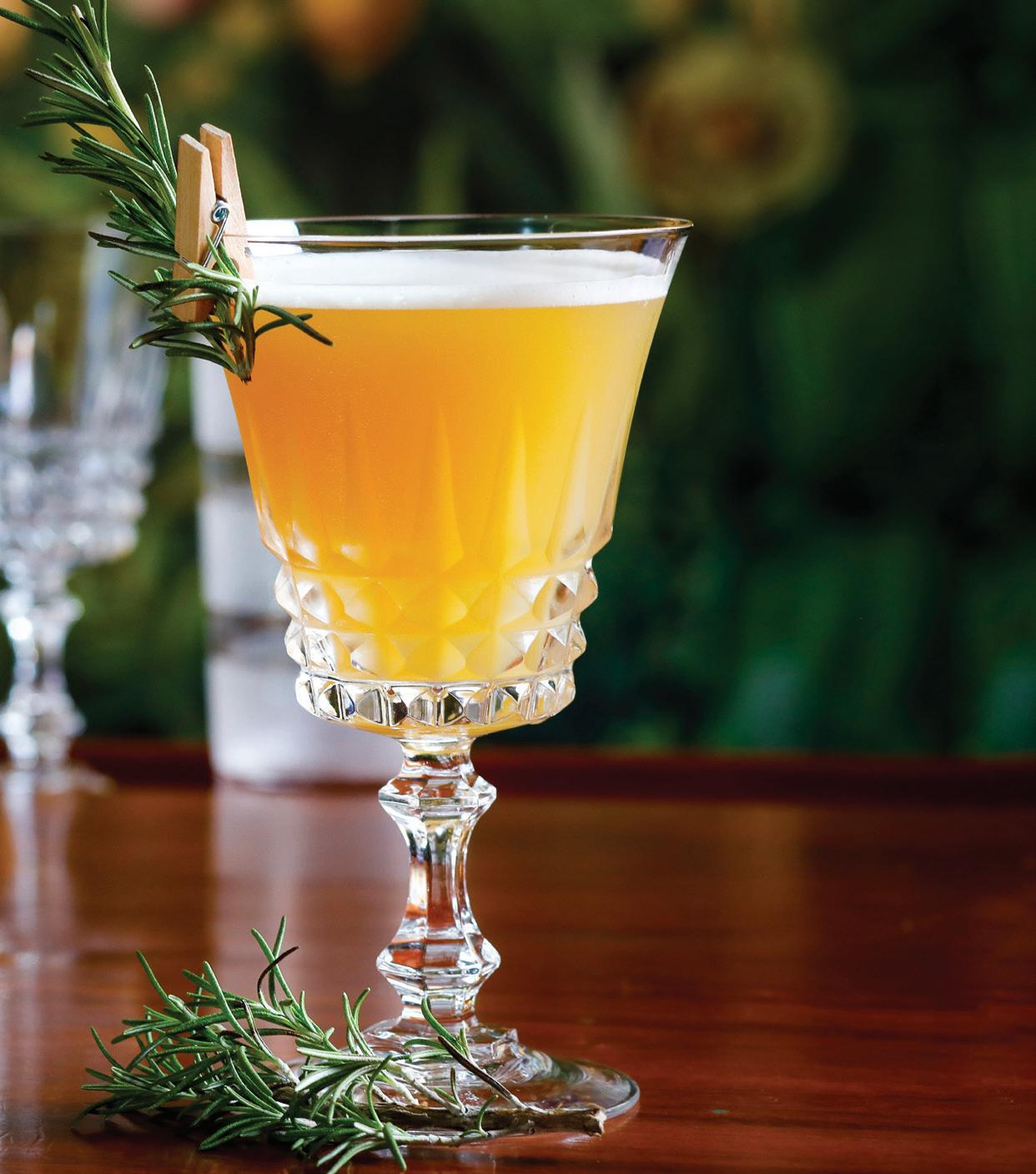
INGREDIENTS
2 oz Flower Honey
2 oz fresh squeezed lemon juice
4 oz gin
DIRECTIONS
Add the ingredients to a shaker. Fill shaker with ice. Shake and strain into a cocktail glass.
INGREDIENTS
1/2 cup honey
1/2 cup water
1/4 cup edible flowers of choice (Lavender and rose work well. If you don’t have access to either, try rosemary!)
DIRECTIONS
Bring honey and water to a boil. Take off heat and add flowers.
Let sit for 15 minutes. Strain out flowers. Can be stored in an airtight container in the refrigerator for up to 2 weeks.

INGREDIENTS:
2/3 cup freshly squeezed satsuma juice* 2/3 cup honey
2 tablespoons ground cumin
Salt and pepper
1 whole chicken, split and cut into two halves 2 satsumas, cut into quarter wedges (with peel)
DIRECTIONS
Preheat oven to 400 degrees. In a large roasting pan, combine satsuma juice, honey, cumin, salt and pepper in a bowl and whisk until smooth. Place chicken and satsuma wedges in pan. Chicken should be skin side up. Pour the liquid over the chicken, leaving 1/2 a cup.
Roast chicken in oven for 10 minutes. Spoon juices over chicken and return to oven. Continue to baste chicken every 10 minutes.
After 40 minutes of roasting, check internal temperature of chicken. Continue cooking until it reaches 155 degrees.
Honey is a natural food packed with a mix of amino acids, vitamins, minerals and antioxidants making it a smarter choice of sweetener. Its sweetness also adds more depth to a dish when compared to regular granulated sugar. But along with its nutritional qualities, it also packs a hefty caloric punch, so it’s not wise to overindulge.
Remove chicken and baste one last time. Let the chicken rest 5 minutes before serving. Serve the chicken with the satsuma wedges; they are fully edible!
*If you cannot find satsuma, mandarin orange can serve as a substitute.
Try out Perennial's fermented beverages in regular-featured flavors including ginger ale or root beer or seasonal options like strawberry. Bottles ready to go home with guests are housemade from locally-sourced ingredients.



Montgomery’s Perennial restaurant emphasizes an Alabamabased eating experience. Owner Deanne Allegro works directly with exclusively Alabama-based farms and purveyors to obtain its food and ingredients, ensuring every bite is hyper fresh and local, as well as ever-changing. Similarly, Perennial’s bar contains all liquors bottled or distilled in the state, and its cocktails are crafted using classical builds and seasonal ingredients. Whether you order one while visiting Perennial, or you use the recipe to whip one up at home, do not skip the Bees Knees sipping experience. Tangy, floral and just a little bit sweet, the sunnycolored cocktail laced with honey is summertime in a glass.

Blooms of all kinds, including those on view from her own backyard, fuel Sara Kathryn Hopple, and their forms find their way into almost every piece of art she creates.
by jennifer kornegay

artworksSaraKathrynHoppleoftenreferstoher as “love letters,” pointing back to a make-do material she used when she first picked up a paint brush and palette during the pandemic. “I began painting on envelopes because that’s just what I had on hand at home,” she says.
Montgomery artist Sara Kathryn Hopple. She’s drawn to blooms’ visual appeal but also their resilience. And even their flaws grab her attention. Through her floral-focused pottery and paintings, she passes on what she sees in the hope that viewers discover their own meaning in the art she makes, including her contributions to the Joy to Life Foundation’s Artists’ Collection. Here, Sara Kathryn explains how she got into art, illuminates her sources of inspiration and shares the personal passion behind her choice to lend her talent to JTL.

JOY: Have you always been into art?
SKH: I come from a family of artists, and I’ve been interested in art for as long as I can remember. I have done pottery since high school, and a favorite pastime growing up was going treasure hunting at Good Will and Salvation Army thrift stores with my mom looking for pottery pieces. I still have the treasures we’d find all around my house. And yet, I didn’t really consider myself a creative person. I got my MBA in healthcare management and was working in a non-art job. But then, during Covid, I started making pottery again. I have an auto-immune disease that put me at high risk, so I had to stay at home a lot, but I realized how much joy art brought me as soon as I started it again. It means so much to me to make things and then be able to give those things, those pieces of myself, to people I love and brighten their day a bit. So, in the beginning of 2023, I quit my big-girl job and pursued both pottery and painting full time.



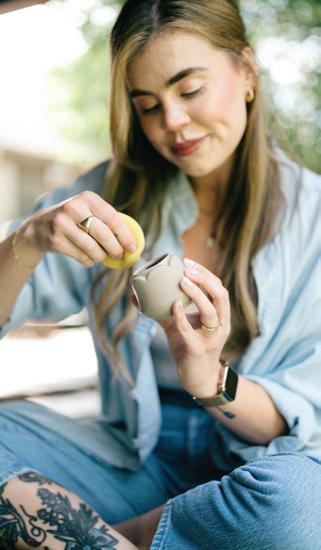
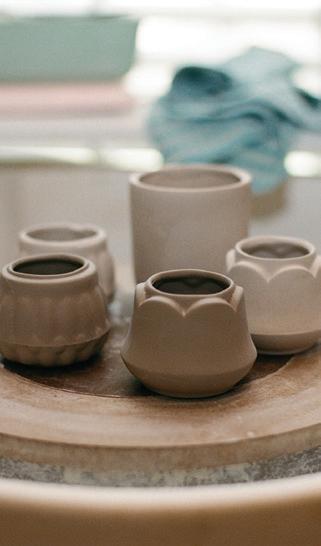
What drives and inspires your work?
All of my art is, in some way, a tribute to my mom. She passed away six years ago, very unexpectedly, so I see my art as a way to keep my memory of her alive. And all of my work, both painting and pottery, has a floral theme. That wasn’t really intentional at first, but I am so inspired by nature that it just kept showing up that way. I live on a golf course and have a view from my studio of all the green and pops of color from the abundant blooms there; the magnolias there are especially beautiful. But I also find beauty in wildflowers, in the less manicured landscapes. Sometimes things that aren’t perfect are just as appealing.
What do you hope others get from your art?
In my pieces, I want to transport some of nature’s beauty inside, but my goal is to also make it a little different and to make it elegant. I hope when people look at them, they feel some of the inspiration I poured into it, and I hope viewing it is like a pause that lifts you above whatever is right in front of you or whatever is going on. Also, most of my pieces are small, and that’s because they’re intended to be given to others. They’re my love letter to others, but I hope others pass them on as a love letter to someone they care about.
What motivated you to partner with Joy to Life Foundation and contribute to its Artists’ Collection?
I’ve done the Walk of Life for 10 years, and that was my only involvement with or real exposure to breast cancer until 2020 when my older sister was diagnosed with triple negative breast cancer while going through divorce
and during COVID. She had a double mastectomy and underwent chemo and radiation and then reconstruction, and she had to do all of it pretty isolated. She’s doing well but still working through all of it, but I can see how brave and strong and resilient she’s been, and that’s inspiring to me. So, partnering with the Foundation became really significant to me; if I can just play a small part in the crucial work it does, I’m proud and honored to do it. I feel like the JTL pieces contain some of the love I give my sister, and now others can share that and spread that with whoever in their life might be on a breast cancer journey. I want these pieces to be reminders that there is still joy and beauty around even amid pain and loss. And there are brighter tomorrows. My sister is now remarried and pregnant.
What do you get out of your work, particularly the creative process?
I am a type A personality, so I struggle to slow down and be in the moment, but making art allows me to put myself first and be present and escape the distractions of daily life instead of wondering what else could I be doing or what else should I be doing. It is truly the only time I am quiet and peaceful. When I’m not making, I’m just so on the go. When I sit down in my studio, everything stills, and I’m not thinking ‘I have to make this thing.’ I’m simply there, and I let it move me and see where it takes me. I’m surprised sometimes by what I can create and what it becomes. It also fills me up to see others connect with what I’ve made. Maybe it sparks a happy memory for them, or marks a special moment in time or a special relationship. And the best is when one of my pieces motivates someone to give it to someone else. Gifting is truly my love language.

Everybody is creative, so if you’re feeling the urge, just start making. If you try, the worst thing that could happen—you don’t like it, so you don’t keep doing it—is the same as if you never gave it a shot, so why not? And once you start, play. Let go of what you think it has to be. The freedom that comes from that kind of creation is so beneficial. - SKH thoughts



Last summer, Sarah Murphy didn’t have any inkling a health issue was lurking in her body. Breast cancer didn’t occupy even the tiniest space in her mind. Until it did. After a routine mammogram and a biopsy, she was diagnosed with Ductal carcinoma in situ (DCIS), a form of breast cancer. She freely admits to the overload, the fear and the desire to “just get it out.” And this openness played a key role in her recovery. She’s just as honest here, getting real about what she felt, what she needed from others and how she pushed herself to stay positive.
Tell us about your cancer diagnosis and treatment. Last year at the end of July, I went for my yearly physical. I was healthy and blood work was good. My primary care doctor suggested I do a baseline mammogram since I was 38 and my maternal aunt had breast cancer many years ago. I said, “Oh, ok, why not?” and she scheduled it for me that week. When I went in to get my first mammogram the nurse told me that I would most likely get a call back this time since it was my first one, so when I got a call to go in for more imaging, I thought nothing of it. When I went back for more imaging, I knew the radiologist was going to view the images that day. When she walked in, I could just tell they had seen something. My gut never lies. She told me that they found some calcifications in my right breast. She told me that they are extremely small, and
that they are typically benign. Once again, my gut told me this was most likely cancer. I had a biopsy scheduled, and a few days later I got the call. I was told I had breast cancer. It was DCIS.
The radiologist was the absolute sweetest, and she immediately started giving me information on the next steps, appointments that would be made, surgeon suggestions, etc. My brain was on overload, and I think it took a long time for it to really hit me. My family was shocked. I was 38 and never had any lumps or bumps. My oncologist originally suggested a lumpectomy and some radiation, but once I met with my breast surgeon, she suggested a mastectomy. After reviewing the size of the area, she saw that it was too large in her opinion to do a lumpectomy, and it was a high grade of cancer. They found this cancer in the very early stages and minimizing my risk of recurrence was top priority. I made the choice to have a double mastectomy. While recovery has been far from easy, and we had some BIG hiccups along the way, it was the right decision for me. A few weeks after surgery, I got a call from my breast surgeon with the best news ever: My pathology results came back, and I was officially cancer free! While I still have reconstruction surgery coming up here soon, the hardest part was over for me. I can handle anything thrown my way knowing I beat cancer.
What was your first thought when you heard the diagnosis?
I wanted it out of my body! I kept telling my mom I was just ready to get it taken out. I was so worried about it spreading. It was contained in the duct, but I was terrified of it moving into stage one, which was probably not likely in the span of time I had until surgery, but cancer is scary. Chemo was my worst fear. I saw my aunt go through it and the effects it had on her then and still has on her to this day.
HEAR FROM SURVIVORS, COMPANIONS AND CAREGIVERS IN OUR
I wanted to be able to talk freely about everything. I am big into sharing things that I am going through. For me that’s how I cope with the hard stuff.
Through the treatment process and after, what did you want and need from your friends and family?
I just wanted support; emotional support for me was huge. I wanted to be able to talk freely about everything. I wanted to let the tears flow when I was having a hard day coping with my new reality. I am big into sharing things that I am going through. I told everyone everything about the process. I know to some that may seem attention-seeking, but for me that’s how I cope with the hard stuff. It’s a way to get my feelings out. I also knew that the more people I told, the more prayer warriors I would have out there. So many people cheered me on, and that honestly was the greatest feeling.
What forms of help and support really stood out?
My tribe showed up! Between my husband, family, friends, neighbors and church family I had so much support. I was beyond blessed throughout this entire journey. My husband and I don’t live near our families. They are both in North Carolina where we were born and raised. When I was diagnosed that was the worst part for them (and me too). They wanted to be here for everything, it was the unknowns that were challenging and scary. My dad cried for days.
But the community and family we built here in Alabama are everything we could ever ask for. They had a meal train set up for us, some donated money, gift cards and my girlfriends
“EMOTIONAL SUPPORT FOR ME WAS HUGE.” - SARAH MURPHY
gave me a sweet care package that had all the things I would need post-surgery. I mean they did the research! We were far from alone in this battle. My church small group prayed over me after we found out my diagnosis, and my church continually prayed for me throughout the process. We felt every one of them. My family often asks, “Why do you live so far away? Why Alabama?” and this whole journey showed them why.
What one thing that you did for yourself most helped you cope?
Honestly, I just tried to keep things as normal as possible. I physically couldn’t do a lot of what I was used to doing after my double mastectomy, but I didn’t want to have too many quiet moments. The quiet moments were when the sadness or the “woe is me” thoughts would hit. Quiet moments were the ones I questioned “why me?” and I didn’t want to do that. I was going to get through this process with as much positivity and grace as possible.
I continually told myself “It could always be worse.” That was kind of my motto. We caught the cancer early, and I was going to survive. I wanted to show my 5-year-old daughter that this diagnosis didn’t have to change me. Maybe it did in physical ways, but it didn’t have to kill my spirit. I wanted her to understand that I was going to be okay, and I never wanted her to worry.
What advice would you give others on how to approach and help their loved one going through cancer treatment?
I would just tell them to be there for them, for whatever they may need. My husband has been a rock star. He truly honored our wedding vows these last several months, in sickness and in health. He took care of everything. He never missed a doctor’s appointment (he always had the best questions); he emptied my many, many drains every single time; he set alarms in the middle of the night and during the day to ensure I got my medications on time; he bathed me; took me to the bathroom; he did it all. And he never once complained about it.
My sisters both changed Thanksgiving Day plans so that they could travel here to be with me and to help. I didn’t have to be alone for the holiday. My parents were here for the surgery and my inlaws came later to pick up another shift. We had friends that took our daughter for playdates and made sure she was occupied so that we could rest when needed. We didn’t have to cook a meal for two weeks. Everyone just made everything easier for us to focus on recovery, healing and getting better.
Remember and reimagine holidays and special occasions. Treatment can change the ability to travel or being together may look different.
Add the patient's children into your own family activities to offer the patient and other loved ones time to rest.
Helping handle meals and grocery shopping removes an essential to-do from daily life, especially for families with children.
Combine resources with other friends to cover fees for housekeeping or lawnmaintenance services.
A sincere, thoughtful note of encouragement ranks high on the list of items a patient needs most.
Rest and comfort don't come easily in hospitals and treatment centers. A few simple comforts remind your friend they are in your thoughts and bring a loving, and practical, pick me up. A few ideas to include: a warm blanket a journal or devotional bookmarks with happy messages or a funny quote hand-made cards from kids a joke book or word puzzle book earplugs for creating calm an uplifting book or fun, easy read a small calendar for appointments adult coloring book fragrant hand sanitizer

More than 20 years of the Joy to Life Foundation’s Walk of Life have been wonderful. But, we’ve got some big news to share. We’re making some exciting changes to our 2025 Walk of Life.

Our “remixed” Walk will consist of multiple events to be held throughout the month of October in different locations around the River Region. Each event will be familyfriendly and full of music, games, food and fun—plus something special for all breast cancer survivors who stop by!
The “remix” will culminate on October 25 with a special “Night of Joy” concert featuring Alabama’s own Ruben Studdard at the Montgomery Performing Arts Center. It promises to be a celebration of life you won’t forget, so don’t miss out.
Stay tuned for details on how you can join us as we all come together to honor, celebrate and remember throughout Breast Cancer Awareness Month with Walk of Life: Remix!

On Saturday, October 25 at 7pm, Joy to Life invites everyone to attend an uplifting evening of sweet sounds at the Montgomery Performing Arts Center (MPAC) with Grammy-nominated artist and winner of season two of American Idol Ruben Studdard!
Ruben will be joining the foundation as part of his “The Masterpiece Tour.” This new show will feature Ruben’s biggest hits, a handful of songs paying tribute to his idols, and songs from his brand-new album.
Tickets are on sale at the MPAC box office, so call (334) 481-5100 or visit mpaconline.org to get yours. Make plans now to join us for this musical celebration during Breast Cancer Awareness Month.
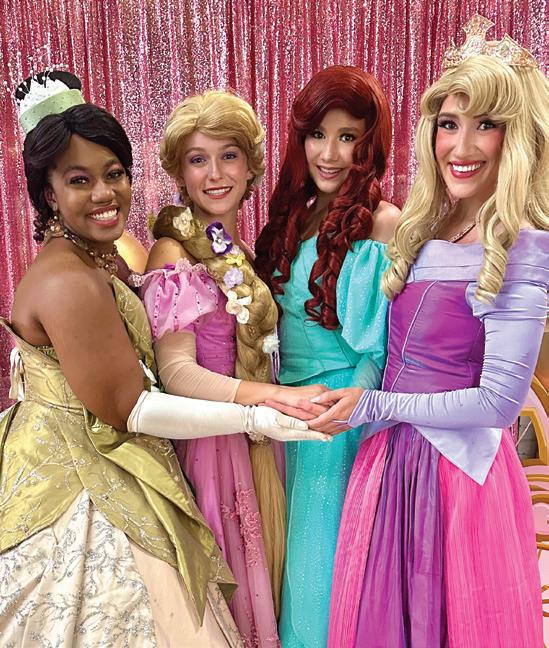


Join the Joy to Life Foundation for some fun Biscuits baseball action and some fundraising on July 19 at 6:05 p.m. and experience a magical Princess Night at Riverwalk Stadium. You can meet your favorite princess characters for unforgettable photo opportunities. Be sure to stop by our station on the concourse for lots of fun and some sweet Joy to Life swag! And who knows? You could get picked to play one of our Pink Trash Can games on the field. The night also features a special pink jersey auction benefiting Joy to Life, making this a fun and meaningful event for all ages.

Have you heard our podcast, Everything Joy to Life? If you haven’t, you’re missing out on some amazing stories from people like:
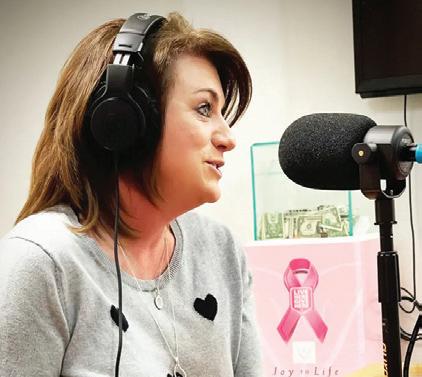
TINA HODGE who has provided compassionate leadership to breast cancer clinics in the central Alabama area (and continues to do so) and has helped guide countless women and men through their breast cancer journeys. She found herself diagnosed with a genetic predisposition for cancer and made the decision to undergo a series of surgeries to reduce her risk of developing the disease becoming a “pre-vivor” in the process!
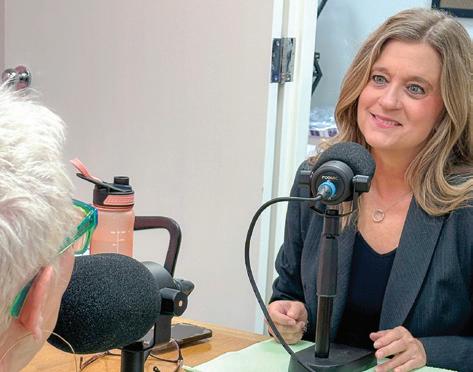
AUTHOR KYM KLASS who shares the circumstances in her life that moved her to explore the topic of mental health in many of her columns and in her book, “One More Day: a powerful true story of suicide, loss, and a woman’s newfound faith.” She also shares how she made it through being physically assaulted and how therapy, along with finding people who had similar experiences, helped her get on the path to healing.
JANET BOLTON who credits a Joy to Life selfexam shower card she picked up during a visit to the Gulf Coast from her home in Ohio with literally helping save her life.

ANTHONY ALLEGRO AND JACOB LAPUTKA FROM HANDS ON HEALING who stopped by to share a wealth of knowledge that will open your eyes to a new way of looking at how your body works and show that the way you think has an amazing impact on the way you move.
DR. LOIS SCHULMAN who helped us navigate the sometimes-overwhelming amount of information regarding plant-based diets and shared why it’s a smart way to eat by explaining how it benefits our bodies.
NEW EPISODE IN JULY catch them all
VISIT JOYTOLIFE.ORG AND CLICK ON THE “PODCAST” MENU BUTTON TO TUNE IN TO ALL OUR EPISODES.
LIVE HERE. GIVE HERE.
DEANNE ALLEGRO (Associate Clinical Professor in the Department of Kinesiology at Auburn University Montgomery) dispels some nutrition disinformation by playing a game of “Truth or Myth” and more. Hear her thoughts on how important nutrition is as she explains the benefits of a plant-based diet.
Plus, find recipes from Deanne Allegro on page 14.
The Joy to Life Foundation is thrilled to announce we have received grants from the National Breast Cancer Foundation (NBCF) as well as the American Breast Cancer Foundation (ABCF). Both these grants are much needed and will be quickly put to use, allowing us to continue our fight against breast cancer in all 67 Alabama counties. The support we receive from both of these wonderful organizations is critical in helping us maintain, and even expand, our efforts to provide life-saving breast health services to those in need throughout the state.
THANK YOU
MANY OF US PUT DOCTORS, NURSES AND OTHER MEDICAL PROFESSIONALS ON A PEDESTAL, SEEING THEM AS LARGER THAN LIFE.
The best of them give patients more than pain-relieving or life-saving treatments. They deliver care and encouragement covered in compassion that is also life-giving. Yet, they’re all everyday people, too; they face their own personal struggles and their own health issues. Montgomery oncologist Dr. Scott McDaniel shines as an example of a physician embodying all of the above; that’s why he is the first medical professional we are profiling in our new Healthcare Heroes series. Read on to learn his thoughts about the joy present at the Montgomery Cancer Center and how his own cancer journey shaped his approach to his patients.
How do you handle the emotional burdens you face in your job?
A:
This job overall can be a challenge, but each individual patient interaction is so unique and so important, that I don’t feel overwhelmed or stressed by them. I strive to do the right thing for the person in front of me that day, at that moment; that is what I was called to do. Also, my faith supports me. If I didn’t know Jesus and didn’t have that faith, I believe I would struggle a lot more with the big picture of what I do.
What is the most essential thing you believe you do for your patients?
People look to their oncologist for guidance in treatment planning and for a calming demeanor, but I also hope I bring a sense of encouragement. Even in the tough conversations, there are ways to encourage, so I see that as part of my job, too.
What would you like to share about your team and the overall atmosphere at The Montgomery Cancer Center?
It is a true team approach; it has to be. And I feel so blessed to work with people who come to the cancer center with unique qualities and qualifications that become greater together. I have three fantastic nurse practitioners, who provide excellent clinical care but also
great emotional support and the TLC patients sometimes need as well. The nurses in the treatment room are amazing too. The schedulers, the radiology techs, the volunteers, the pharmacists, really everyone who interacts with patients gives just a little more, a little extra, and that’s because they feel called to work here. It’s not just a job. Many patients tell me they’re blown away by the positive environment as it’s not what they expected. People think a cancer center will be doom and gloom, but it is uplifting inside MCC. That’s what drew me to the Cancer Center and Mongomery. I just try to do my part to expand that.
What’s the most rewarding part about what you do?
With each patient, I get inserted in their life in a difficult time. When they walk out after an appointment, and I can tell either their shoulders have relaxed or they’re smiling or they just tell me, “I was so scared coming in, I’m less scared now,”—that is rewarding. And the doctor-
patient relationship is just that—a relationship. There are so many instances where I’ve gotten as much or more from a patient interaction as they did. They get support and guidance, but I often take away something positive as well.
Tell us about your cancer journey.
I first was diagnosed in 2010 with a rare non-Hodgkin lymphoma. I was out of work for nine months to have chemotherapy and then an autologous stem cell transplant. I was in remission and back to normal following that. Then, in 2024, I began to feel tired and run down. We did some tests, and I was diagnosed with complication from my prior treatment. The treatment for this was another stem cell transplant, this time with a donor. During our donor search, we found a perfect match and moved as quickly as we could. I spent four months in Houston at MD Anderson getting and recovering from the transplant and came home just in time for
my daughter’s 18th birthday, which was the goal. I am now in complete remission and have returned to work. It was overwhelming, but in a good way sometimes, particularly feeling all the prayers. I knew I had an army of prayer warriors in Montgomery and all over, and I could feel the support of that. My family and I were and are so appreciative.
How have your cancer battles influenced your approach to your patients?
I believe they have improved it. I said the first time I was sick that I hope I didn’t go through all of this and not pay enough attention. These experiences are all a part of God’s plan for my life and have taught me so many things, including the importance of being encouraging and of patience and compassion. Being on the other side and being the recipient of those things just strengthens my desire to give them to others. God used these events for his glory and to help me better meet the needs of others.

Dr. Scott McDaniel can’t remember a time when he didn’t want to be in medicine. “I always knew I wanted to be a doctor,” he says. After graduating from UAB medical school and during the oncology rotation of his internal medicine training, he identified a gift he felt led to share. “I realized God had given me the ability to talk openly and honestly with patients, even on the difficult topics, and to do so with compassion,” he says. “That’s when I knew working with cancer patients was for me.” He joined the team at The Montgomery Cancer Center in 2006 and has been there ever since. The chance to be on the cutting edge of medical science also appealed to him. “I had the inclination that the science behind cancer treatment was about to explode, and I love learning new things,” he says. “Thankfully I was right. So many advances have been made in the last 19 years.” SPREADING JOY:
“We all have the ability to affect those around us in a positive way. I’ve watched others go through cancer in a way that inspired me. As I went through both of my cancer journeys, I hope I did so in a way that gives others hope along their journey and the faith to persevere.” - Dr. Scott McDaniel
“The Heiress,” by New York Times bestselling author and Dothan native Rachel Hawkins, tells the tale of Cam and Jules as they are drawn back into Cam’s past and the mysterious and magnetic heiress who adopted him and brought him to live at her family’s lavish estate in North Carolina’s Blue Ridge mountains. She’s been dead more than a decade, but so many questions remain. What will the couple discover and what will it mean for their future? This gothic mystery is a fun thrill ride for summer.
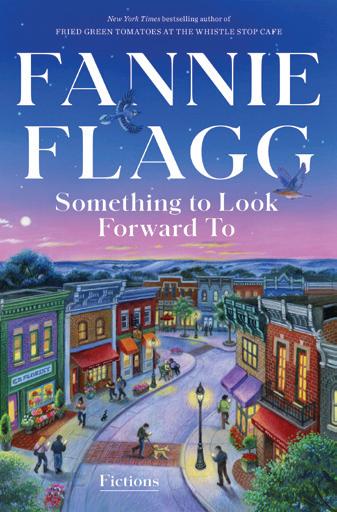
Fall into another time or place with these novels by Alabama authors.
In “Something to Look Forward To," beloved Bama writer Fannie Flag brings her quick wit, warm humor and positive insight into human nature to bear in a series of interconnected stories. Each tale highlights how a diverse range of characters all across America deal with and overcome the crazy curveballs and challenges constantly popping up in this thing we call life.
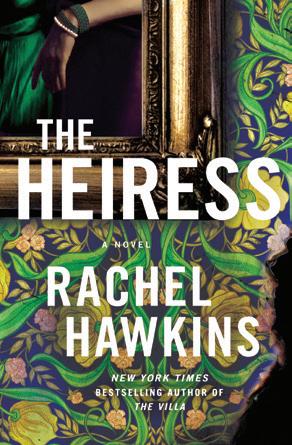
Montgomery’s Tom Spencer (Tom Perrin) honors the crime fiction of a century ago in “The Mystery of the Crooked Man,” a fun, twisty mystery tailor-made for fans of Agatha Christie books. The main character, cranky, boozy, murdermystery addict Agatha Dorn, must solve the killing of her ex-lover before she ends up dead herself.
Though she’s been gone almost a decade, iconic Alabama author Harper Lee debuts new work this fall. “The Land of Sweet Forever: Stories and Essays” will be released posthumously in October, and many of the never-before-seen narratives were written by a young Lee years before she turned her focus to her most famous work, “To Kill a Mockingbird.”
Check out the latest nonfiction narratives with an Alabama focus.


In 2019, the remains of the Clotilda, the last known slave ship to arrive in the United States (in 1860), were discovered in the Mobile River. The ship carried 110 enslaved souls into Mobile Bay and was transporting them for sale after the international slave trade became illegal; it was burned and sunk in the river to cover up the crime. In “Survivors of The Clotilda,” Dr. Hannah Durkin tells the stories of the Clotilda ’s 110 captives in the years following the vessel’s landing in Alabama, including the formation of North Mobile’s Africatown, a tight-knit community still existing today.
The South is crisscrossed by a massive network of rivers that ebb and flow and bring life-giving fresh water to countless ecosystems and communities. In “Southern Rivers,” Alabama nature writer and biologist R. Scot Duncan explores these rivers and their current management, making the case for needed protections and conservation actions to preserve and restore their biodiversity and vitality.


Discover heaping helpings of Alabama food info, including the history of century-plus-old Chris’ Hot Dogs and its many celebrity diners, an exploration of the state’s famous tangy white sauce and mouth-watering journeys to shrimp-catching on the coast and goat-cheese making in the north. But the best bite is filling up on the stories of the amazing people behind the foods that make Alabama so tasty.
Alabama’s famous foodie and chef Martie Duncan serves up her thoughts on the best spots to eat, the most essential Alabama dishes worth the drive and multiple recipes for favorite examples of camellia-state cuisine in this cookbook and travel guide combo.
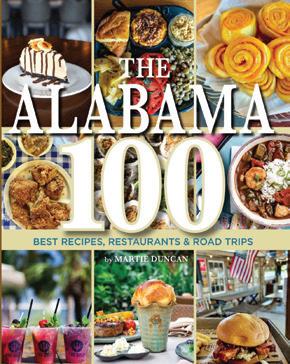
SHOP LOCAL


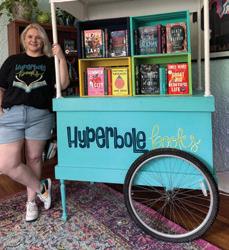
Kaitlyn Wearden takes her love of books on the road in the River Region with Hyperbole, her mobile indie book store. With her cute little book cart in tow, she brings the latest and greatest reads plus her personal recommendations to all kinds of events in Montgomery, Pike Road, Prattville and more. Follow her on Instagram (@hyperbolebooksal) to find out where Hyperbole will pop up next!

BY KYM KLASS
Master these time-management techniques and get more done with less stress.
where do the hours go?
There never seems to be enough of it, and no amount of money can buy you more of it. We’re all stuck with the same 24 hours in a day. And in those hours, we have myriad tasks and to-dos related to our various responsibilities and roles. To increase our daily productivity, reduce our stress and reach our longterm goals in both our personal and professional lives, we’ve got to use our limited time efficiently and effectively. But how do we achieve that? Use these tried-and-true time management techniques.
General time management tips work well for most people, but we all have different approaches to work (and life), and there are several time management styles that are tailored to certain personalities and more specific time management issues. A quick internet search can provide details on popular methods like Time Boxing, “Eat the FROG” and Pomodoro.
Before you start a time-management journey, pick a destination by identifying some goals. What would you do with more time? What are you trying to achieve in your life that efficiency could help with? Once you know what you want, you can create a specific plan to get it. Remember to make your goals measurable and realistic though. Don’t set yourself up for disappointment by setting unattainable goals. And write your goals down. Multiple studies show that you’re more than 40 percent more likely to reach goals and make choices in keeping with your priorities when you do.
Effective time management starts with a daily roadmap. Start with a to-do list. It’s a simple system for organizing your day, but it works. The thrill of crossing things off of it as you finish tasks is a bonus!
Your daily plan (and daily list) should show which items or tasks are the highest priorities. This allows you to focus on the most important things and feel confident about allotting a certain amount of your precious time to them. You can try out several different methods here. You can rank every item from 1 to 10, with No. 1 being crucial and 10 being the least important. Or divide tasks into three priority levels: high, medium and low and arrange your list that way.
Proper time-management is the key to overcoming the feeling of being overwhelmed. But feeling overwhelmed is also a key reason many people fail to manage their time well. Dividing large—and overwhelming—tasks into smaller, more approachable pieces is a smart way to break this cycle. Focus on one small chunk at a time, tackle it, and then move on to the next small chunk.
Giving a task your undivided attention is critical to getting it done, but also increasingly difficult with countless things vying for our focus. Learning how to limit distractions is essential. Figure out what specific things (social media, pets, etc.) are most likely to derail your dedication to a task and create a strategy to combat it. Should you put your phone in a drawer? Do you need to turn of email notifications during certain tasks? Do you need to find a more secluded spot to work on certain things? And give some of today’s productivity apps a try. They vary in how they work, but most help you block distractions and avoid unproductive activities that waste time.
While the phrase “setting boundaries” sounds like you’re fencing yourself off from the world, you’re not. When proper boundaries are in place, you’re better able to establish and maintain close and healthy relationships with others. Remember to clearly communicate your boundaries to others so you set the right expectations in them. And learn to say “no.” Root yourself in the idea that your priorities are as important as the needs of others, and you’ll learn to say no without shame or guilt.
Once a week, take a step back and look at what’s ahead in the weeks to come. Understanding what’s coming down the pipeline gives you a bigpicture view of your life so you can see where you’re over-scheduled (and remedy it or at least get prepared) and where there are free spaces you take advantage of and better spread the load.
Trying to do too many things at once doesn’t mean you get things done faster. In fact, the opposite is usually true; many multitaskers get bogged down by moving between tasks (and the thoughtswitching that requires) and end up doing everything slower. Use your daily plan and focus on one item on your list at a time.
Identify tasks on your plate that someone else on your work and/or family team can (or should) handle and then hand them off. Take advantage of tech. Use shareable digital lists and calendars as well as team project management apps (like Trello) to share and co-manage duties with co-workers. And consider giving your kids more responsibility, like additional house-cleaning or meal-making chores. Bonus: You’re teaching them skills they need!
Relaxing is not time wasted. It’s key to effective overall wellbeing, which is key to time management. When you’re less stressed, you’ll have more energy and get the most out of every minute.
BY KYM KLASS
First, let’s crush a common myth about weightlifting that might stop you from even considering it as part of your life: It makes you bulky. For most, especially women, it’s quite the opposite—it will help burn calories, lose fat and develop muscle, according to experts at the renowned Houston, Texas-based medical center MD Anderson.
You’ll look leaner, and that muscle you do build? It will continue to boost your metabolism. It’s a win-win. And win. “Consistent weight training builds muscle mass, and, in turn, muscle mass creates a buffer against sickness, chronic disease and low-quality life,” said Ashley Jenkins, a personal trainer in Montgomery. “It’s our job to make that buffer as impenetrable as possible. In a society that hyper fixates on specific things like fasting windows, vitamins and supplements, we miss the big picture of prevention by something as simple as weight training.”
And it is for everyone, she said, including her 3-year-old daughter who works out with her and, “thinks it’s the best part of her day.” And it is for one of her favorite clients in her late 70s, who Jenkins said, “runs circles around all of us. It’s not about the bodybuilder physique; it’s about quality of life. The earlier in life you start, the better off you’ll be.”
WONDERING IF YOU NEED TO ADD A LITTLE LIFTING TO YOUR WORKOUT? HERE, WE WEIGH THE BENEFITS AND RISKS OF WEIGHT TRAINING.
As people age, lean muscle mass breaks down, so it’s important to continue to utilize and strengthen the muscle mass so the deterioration doesn’t continue, according to Results Physiotherapy. Weight training can turn this deterioration around and provide benefits such as increasing bone density and reducing the risk of fracture to fragile bones, or osteoporosis. Weight training can also improve balance and increase energy, plus:
• Improve muscle strength and endurance
• Improve posture
• Help manage chronic conditions and pain
• Boost metabolism and help fat loss
• Transform your body
• Boost mood, confidence, energy levels and improve sleep habits
But how much is too much, and how do we know?
Jenkins said most of us really aren’t at risk for overtraining. The greater concern, she said, lies in how sedentary we are. “The longer you sit, the less you move, the stiffer you stay, the worse it gets,” she said. “Our bodies are designed to move and will tell you if it’s too much. Three times a week is a perfect sweet spot to get started. If you’re overwhelmingly sore, notch down the degree of intensity or frequency.”
Intensity can cause issues, with the most common weightlifting injuries (according to Houston Methodist) including back strain, rotator cuff strain, biceps strain and patellar tendonitis. “There’s also the potential for a serious injury—a meniscus tear, patellar tendon tear and even Achilles tendon rupture, for example,” Dr. David Braunreiter, a sports medicine specialist at Houston Methodist, stated on HM’s website. Doing too much over time, too much at one time and using improper form while lifting are the most common causes of weightlifting injuries.
Now that the risks are out of the way, where do weights fall when thinking about our mental state? Can weightlifting make us feel better? A few of the benefits of weightlifting for brain health, according to Psychology Today, include:
Improved brain function, and this benefit is likely to be more pronounced in the elderly.
Better cognition after starting resistance training in people with cognitive decline. Possible decrease in depressive symptoms.
“Weight training plays such a massive role in slowing cognitive decline. There’s a direct correlation between weight training and brain health; it’s our first line of defense against diseases like Alzheimer’s and Parkinson’s. All it takes is 150 minutes of moderate exercise per week to help combat the aging process. And, of course, on a much simpler level, it’s worth showing up simply for the endorphin boost. Save your body, save your brain.” - Ashley Jenkins, personal trainer
BY KYM KLASS
Your feet take care of you, moving you around so you can get things done and have fun. Don’t forget to give them the TLC they need.
Feet are likely the one part of our body we take for granted the most. From the moment we wake up, they walk to the kitchen for coffee, to the shower, the car. All day, we are off and on our feet at work or home, constantly moving. We walk the dogs, run around with our children. Or just, run. Make quick motions with them in pickleball, or demand they get us through long hikes. Up and down stairs.
So, why do we neglect the actual care of our feet? They faithfully take us from Point A to Point B and then do it all again the following day. Here, we shed some light on foot care, with a focus on common issues affecting foot health, how to take care of aging feet, and how to choose the right shoes for comfort and support.
Let’s start with foot care—and ways, according to Live Healthily—you can manage easy care at home to help prevent problems:
Wash your feet often— every day in warm soapy water.
Dry your feet well—thoroughly, especially between the toes so fungal infections don’t develop
Moisturize and file—apply cream all over the foot (but not in between the toes!) and remove hard skin and calluses with a pumice stone or foot file
Cut toenails carefully— trim regularly, straight across
Change your socks often to avoid foot odor—daily, to keep feet fresh
Problems to Lookout For Hygiene aside, keeping ahead of common foot problems is also key to foot health. Watch out for these issues:
Plantar fasciitis. One of the most common causes of pain on the bottom of the heel (according to the American Academy of Orthopaedic Surgeons), this issue occurs when plantar fascia on the bottom of the foot becomes inflamed. It can be caused by tight calf muscles, obesity, increasing activity levels and standing for long periods of time on hard surfaces. Wearing supportive
footwear, stretching the foot thoroughly before and after exercise, and rest can help ease the pain, according to Medical News Today.
Ingrown toenails. They can be caused by wearing footwear that does not fit properly and if toenails aren’t trimmed properly. This causes swelling, tenderness and even pus due to infection. MNT suggests treating (and preventing!) this by soaking feet in warm water and gently drying them, wearing comfortable footwear and taking pain relief medications if needed.
Many local, specialty shoe stores offer fittings for athletic shoes to accomodate specific needs like wide toe boxes or increased arch support.
Athlete’s foot. This ailment finds itself on top of most “common foot problem” lists, but don’t let the name fool you: It doesn’t only affect athletes. This contagious condition appears after you make contact with fungus, usually in wet environments such as locker rooms, public showers and swimming pools, according to Healthline. And while the condition itself isn’t serious, it can often be difficult to cure— although you can treat it with a topical antifungal medication.
While these—and other—foot problems can start when we’re young and continue through the years, as we age, we must pay even more attention to the care of our feet. Our skin thins, joints stiffen, feet can become vulnerable to the cold, and arthritis and degenerative diseases can also cause problems.
Unfortunately, up to 87 percent of people have painful feet at some time in their lives for many different reasons. One-third of older adults suffer from foot pain, stiffness or aching feet, according to HealthinAging.org
To help curb this, DailyCaring.com offers these tips: get properly fitted footwear, promote circulation, trim nails, and monitor sores. Of this advice, finding the right footwear often proves the most challenging.
So, what makes a great shoe? While they can certainly be a fashion statement, when it comes to proper foot support, trendy styles don’t always equate to better. Shoes’ color and look mean nothing if we’re not benefiting in the days, weeks and even years ahead.
Running shoes generally have a lifespan of 300 to 500 miles
Comfort, mixed with support are the keys to fabulous footwear when it comes to footcare. That means high heels and flip-flops can be fine when worn for a few hours to wow at a special event or hanging out at the pool or beach. But for everyday wear, OnlyMyHealth.com recommends:
Choosing shoes with a wide toe box so your toes can move freely; if it’s too narrow, it can squeeze your toes and lead to problems like hammer toes and bunions.
Checking your shoes regularly for signs of wear and replace them when necessary. Having proper arch support so the plantar fascia isn’t strained.
Having shoes with sufficient cushioning to absorb shock effectively.
As we lift our tired feet back into bed each night, we need to be mindful of all they do for us and provide them with the same level of care we give the rest of our body. They’ll reward us with more mileage and less pain as we move through every day.
Baptist Medical Center East has recently completed a major expansion to now offer the largest Neonatal Intensive Care Unit (NICU) between Birmingham and Mobile! The new expansion added 30 infant beds, featuring 18 private rooms—six of which support overnight family stays complete with sleeper sofas, private showers and quiet spaces—ensuring families can remain close during critical stages of development. The remaining 12 infant beds are arranged in clusters to enhance visibility and support open communication among care teams. This state-of-the-art unit is fully equipped and ready to deliver the highest level of neonatal care to our tiniest patients.
+ $10 million expansion, adding 16,000 square feet of NICU space
+ 30 infant beds with 18 private rooms, including 6 for parents to stay overnight
+ State-of-the-art therapies like Nitric Oxide and Therapeutic Hypothermia
+ More than 10,000 NICU care days provided each year
+ Family-centered, modern design complete with a “Little Library” featuring books in multiple languages for parents to read to their newborns

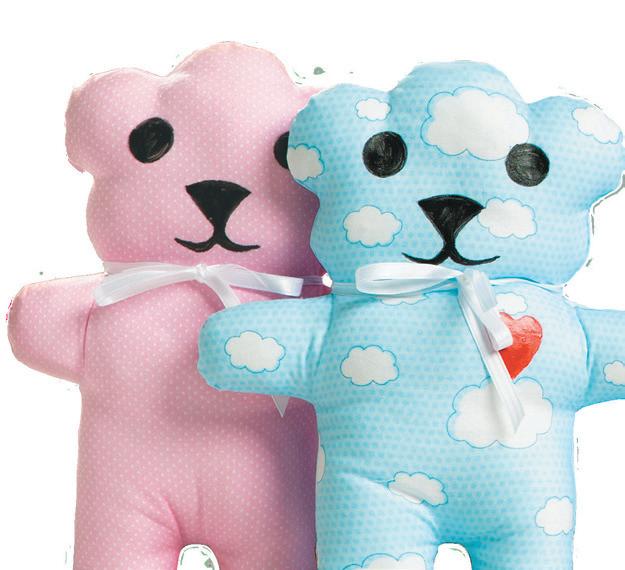
lines smile LEAVING YOU WITH A LITTLE JOY
Just add water!
adds an element of wonder and adventure to outdoor time. Embrace a little drizzle while on a walk or swim.
PLAY BALL
with a twist. Add reusable water balloons to backyard baseball or a beach ball to game time in the sprinkler or pool.
with small pieces of fresh fruit kicks cold drinks up a notch and adds a touch of fun and flavor to your cup.
RIDE THROUGH a sprinkler or water hose with a friend for a clean bike with added fun.
FILM + FLOATS are a great excuse to linger in the pool for an outdoor movie night.
that drip down your face (and hands and arms) guarantee you'll need to head to the tub for a good, wet scrub.

“Battling cancer while pregnant. Thriving with my family today.”
Katie—
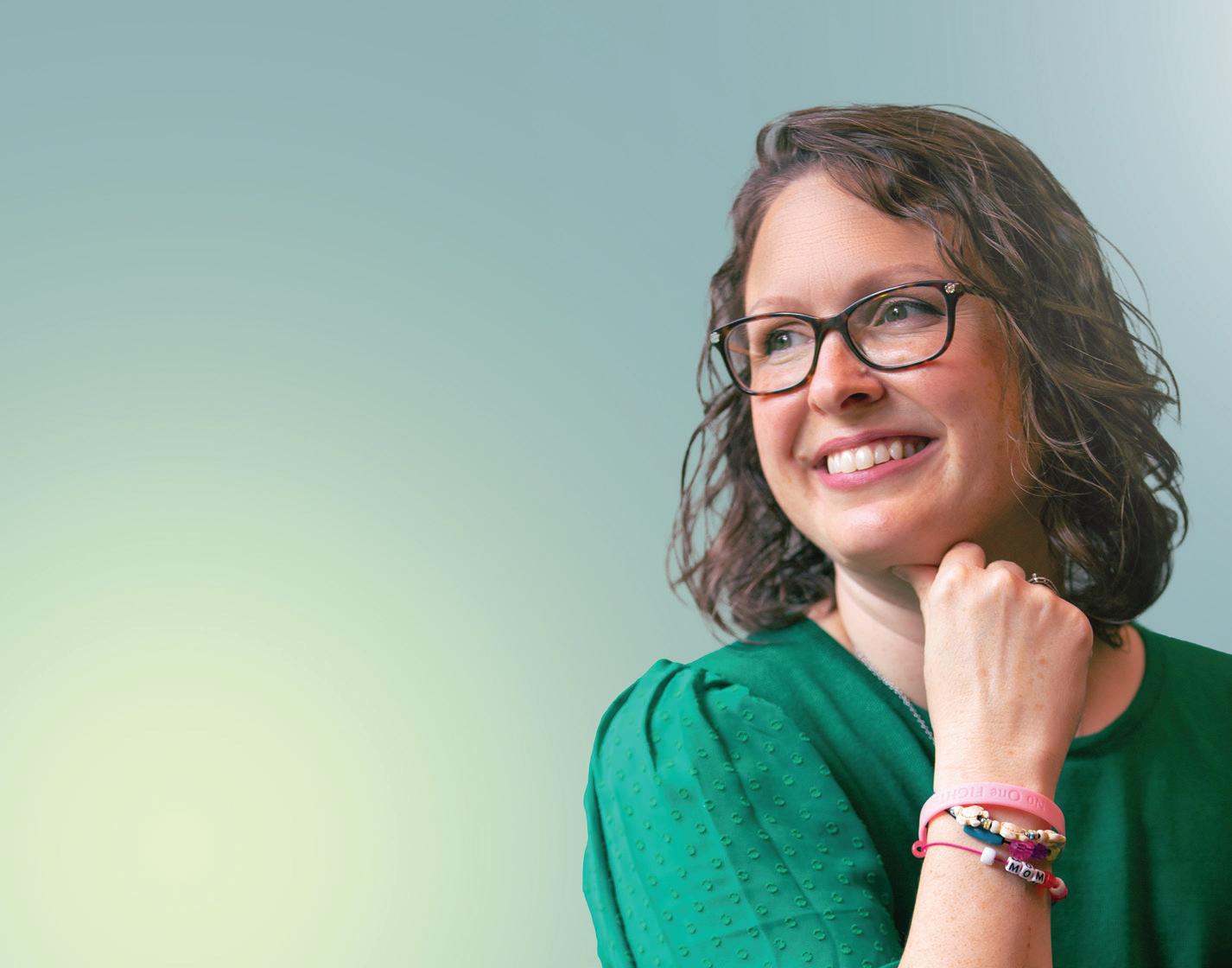
Learning you have cancer is frightening at any time, but combining that with being pregnant as you start chemotherapy, seemed unbearably daunting. My biggest fear was that the treatment would harm my unborn baby. Dr. Davidson crafted a precise, personalized plan and reassured me that my baby would be safe. A second opinion from MD Anderson confirmed the plan. God could not have put me in a better place for this journey, and I feel blessed to have been in the care of Montgomery Cancer Center’s exceptional team, who seemed like angels guiding me through it all. Nine years later, I’m cancer-free and grateful to be watching my youngest daughter—my own little angel—grow up into a beautiful young girl.
LEARN MORE